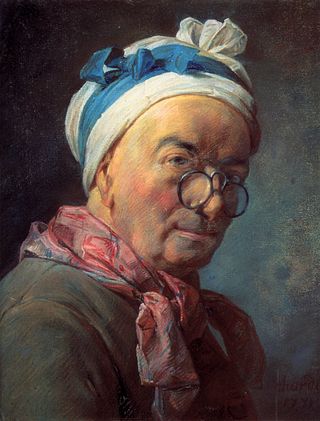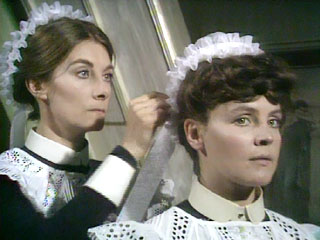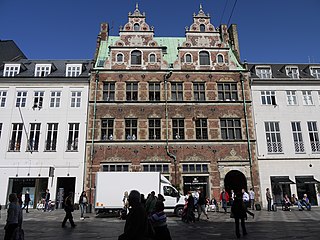
Jean Siméon Chardin was an 18th-century French painter. He is considered a master of still life, and is also noted for his genre paintings which depict kitchen maids, children, and domestic activities. Carefully balanced composition, soft diffusion of light, and granular impasto characterize his work.

A housekeeper is an individual responsible for the supervision of a house's cleaning staff. The housekeeper may also perform the cleaning duties themself.

In great houses, scullery maids were the lowest-ranked and often the youngest of the female domestic servants and acted as assistants to a kitchen maid.

Marie-Louise O'Murphy, also variously called Mademoiselle de Morphy, La Belle Morphise, Louise Morfi or Marie-Louise Morphy de Boisfailly, was the youngest lesser mistress of King Louis XV of France, and the model for François Boucher's painting The Blonde Odalisque, also known as The Resting Girl.

The Milkmaid, sometimes called The Kitchen Maid, is an oil-on-canvas painting of a "milkmaid", in fact, a domestic kitchen maid, by the Dutch artist Johannes Vermeer. It is now in the Rijksmuseum in Amsterdam, the Netherlands, which regards it as "unquestionably one of the museum's finest attractions".

Sarah Moffat, also known as Sarah Delice and Clémence Dumas, is a fictional character in the ITV drama ‘Upstairs, Downstairs’ and its spin-off Thomas & Sarah. She was portrayed by Pauline Collins.

Jean-Baptiste Oudry was a French Rococo painter, engraver, and tapestry designer. He is particularly well known for his naturalistic pictures of animals and his hunt pieces depicting game. His son, Jacques-Charles Oudry, was also a painter.

Girl with a Pearl Earring is a 1999 historical novel written by Tracy Chevalier. Set in 17th-century Delft, Holland, the novel was inspired by local painter Johannes Vermeer's Girl with a Pearl Earring. Chevalier presents a fictional account of Vermeer, the model and the painting. The novel was adapted into a 2003 film of the same name and a 2008 play. In May 2020, BBC Radio 4 broadcast a new dramatisation of the novel.

Young Girl Reading, or The Reader, is an 18th-century oil painting by Jean-Honoré Fragonard. It depicts an unidentified girl seated in profile, wearing a lemon yellow dress with white ruff collar and cuffs and purple ribbons, and reading from a small book held in her right hand. The painting is in the National Gallery of Art in Washington, DC.

Saying Grace or The Prayer Before a Meal is the title of several paintings by French artist Jean Simeon Chardin, one of which was given as a gift to Louis XV. The subject of the painting, a middle-class French family saying grace before a meal, is one of everyday bourgeois tranquillity – Chardin's area of interest – with an uncharacteristic touch of sentimentality.

Anne Vallayer-Coster was a major 18th-century French painter best known for still lifes. She achieved fame and recognition very early in her career, being admitted to the Académie Royale de Peinture et de Sculpture in 1770, at the age of twenty-six.

The Matthias Hansen House, formerly also known as the Schoustrup House, is a Renaissance-style townhouse on Amagertorv in central Copenhagen, Denmark. Built in 1616, it is one of few buildings of its kind which has survived the Copenhagen Fires of 1728 and 1795. The building is now home to a flagship store for the Royal Copenhagen porcelain factory.

Come Out of the Kitchen is a lost 1919 American silent film produced by Famous Players–Lasky and distributed by Paramount Pictures. It was directed by John S. Robertson and starred Marguerite Clark. The film is based on Alice Duer Miller's 1916 Broadway play of the same name that starred Ruth Chatterton.

Jupiter and Antiope is an oil painting by the French artist Antoine Watteau. It is also known as the Satyr and the Sleeping Nymph and was probably painted between 1714 and 1719. Intended to be placed over a doorway, today it hangs in the Musée du Louvre in Paris.

The Stolen Kiss is an oil-on-canvas painting created in 1787, located in the Hermitage Museum, Saint Petersburg. It has been historically attributed to the French Rococo artist Jean-Honoré Fragonard (1732–1806). At 45 by 55 centimetres, the painting is a genre scene influenced by Dutch Golden Age painting, depicting a young couple in a secretive romance, set in the foreground – a subject that was favoured before the French Revolution among French aristocrats.

The Laundress is a 1761 genre painting by French artist Jean-Baptiste Greuze (1725–1805), existing in two versions. The subject of laundresses, also known as washerwomen, was a popular one in art, especially in France.

Interior of a Kitchen with a Woman, a Child and a Maid is an oil-on-canvas painting by the Dutch painter Pieter de Hooch. It is an example of Dutch Golden Age painting and is part of a private collection.

Self-Portrait with Two Pupils, Marie-Gabrielle Capet and Marie Marguerite Carreaux de Rosemond is a 1785 self-portrait painting by Adélaïde Labille-Guiard depicting the artist with two of her pupils, Marie-Gabrielle Capet and Marie-Marguerite Carreaux de Rosemond. It is in the collection of the Metropolitan Museum of Art.

Boy with a Spinning-Top or Child with a Teetotum is a 1738 oil-on-canvas painting by Jean Siméon Chardin, now in the Louvre in Paris, which acquired it in 1907.

The Laundress or A Young Girl Doing Laundry is the title of three oil paintings by the French artist Jean Siméon Chardin. The subject of laundresses, also known as washerwomen, was a popular one in art, especially in France.




















